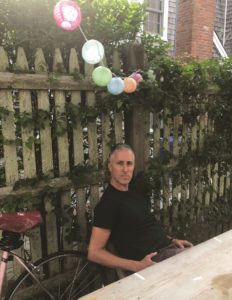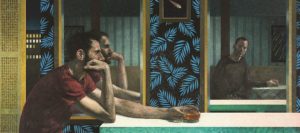“It sort of annoys me when people say, ‘I don’t want to be seen as a gay artist,’ ” Forrest Williams says. “There’s an incredible tradition of homoerotic art.”
Williams is certainly right about that tradition, which extends back through the whole of art history. But queer identity is a more modern phenomenon. When a contemporary painter rejects the label “gay artist,” the rationale is usually that it’s somehow limiting or reductive. And for Williams, that is clearly not the case.

Most of his oil paintings feature male figures, whether they’re nude or not, in a setting that is both realistic and subjective, in a painterly and decorative way. Many of his paintings are set in gay bars, and there’s erotic yearning in the gaze of artist and subject. But they’re less about sex than about loneliness and the lack of connection. In this way, Williams is like a gay Hopper.
The work comes alive when experienced in person, as the artist’s play of texture and light reaches out beyond two dimensions. With a show of new work in a group exhibit at AMP Gallery in Provincetown, opening Friday, July 31, and on view through Aug. 25, that experience is available to all.
Williams grew up in Burlington, N.C., “a small town right in the center of the state, nowheresville,” he says. “I had a nice childhood there. Mom and Dad had two kids, a brother and sister. Dad was a small-town doctor, a G.P. Classic Americana.” Young Forrest was artistic — “the teacher would let me decorate the bulletin board” — but had no idea that art would become his life’s work.
“That person, to me, is like a separate person,” Williams says of his young self. “So much was tamped down. That muffled expression is a gay male thing, and it still informs my work. If you see two figures, they’re isolated.”
He went to Davidson College, not far from his home in North Carolina. He made his big move in his junior year, which he spent abroad, at the University of Edinburgh in Scotland. His eyes began to open. “I remember my father saying, ‘Why would anybody go to a country where they’ve never been and don’t know anybody?’ I said, ‘That’s the point. You’re free to have an adventure and be closer to whoever you’re going to become.’ Growing up in North Carolina, I never went to any art museums. There are things like Titians in the Scottish National Gallery.”
Williams studied literature in college and was involved with theater, and after graduating, he moved to New York City and interned at the storied Circle Rep theater company and cater-waitered. That’s when he came out.

“I met all these people who were fashion designers,” he says, “and I started working for them as an illustrator. That got me to a place where I was drawing a lot.”
He decided to take art courses at local universities. “I went straight for a course in painting from the nude in oil,” Williams says. “It was great! I learned a little about oil paint. I wouldn’t have touched it, otherwise.” A professor suggested he get serious, and he did, earning an M.F.A. in painting at the New York Academy of Art, which has a traditionalist graduate program.
He was 30 when he finished and “mature enough to be a little wiser about my time.” He continued freelance illustrating, painting on the side, and, through a connection, got into a show of New York artists at the Elizabeth Leach Gallery in Portland, Ore. At his first solo show there, Williams says, “Everything sold out. It hasn’t happened since.”
His career was launched. He got picked up by a gallery in San Francisco, and once he was in Provincetown — he fell in love with the place as a visitor, and bought a home in the East End — he spent time at galleries and got to know Debbie Nadolney, who invited him to show at AMP.

“One of the most enjoyable things in life is looking at images,” Williams says. “If I walk into a room, the first thing I’ll look at is the picture of a person. We’re looking for ourselves. I feel like my work is about the self, but what does that mean? The self as apart from other selves and the environment.”
A small graphic element Williams has observed somewhere can be the creative spark for one of his paintings. For example, the fiery wallpaper in the painting Flame Bar, in the AMP show, was inspired by a miniature by Nicholas Hilliard, a portrait surrounded by flames, that he saw in the Victoria and Albert Museum in London. (Williams loves Baroque-era art.) From the various elements of Flame Bar arise multiple points of view: those of the shirtless man with a drink, the woman in a painting on the wall, the absent person whose drink is on the counter, and the artist (and viewer) who observes head on.
“The way I compose something is to get at the psychological underpinnings of the paintings,” Williams says. “The thing that the painting is about, and the way that it is made, have to be of a piece. That’s really a lifetime project for me as a painter.” And, as fate would have it, as a gay Provincetown artist.
Raising the Bar
The event: New work by Forrest Williams, part of a group show with Susan Bernstein, Karen Cappotto, Marc Van Cauwenbergh, Jackie Lipton, and Rick Wrigley
The time: Friday, July 31, through Aug. 25; opening reception (4-6 people at a time) Friday, July 31, 6 to 9 p.m.
The place: AMP Gallery, 432 Commercial St., Provincetown
The cost: Free



